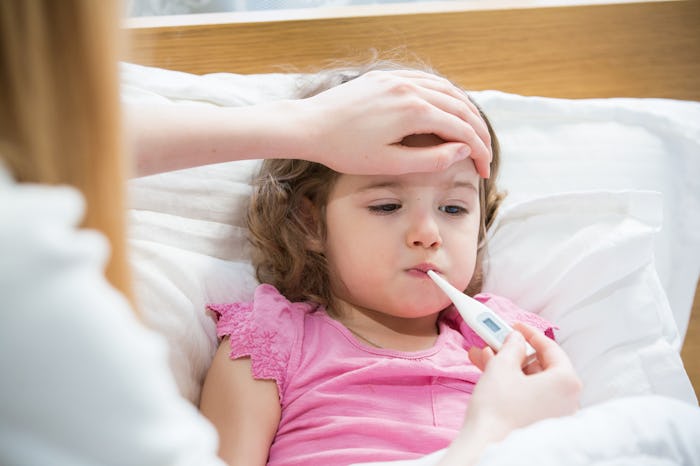Life

Here Are Some Early Flu Symptoms In Kids To Look Out For
The flu. From the moment Thanksgiving rounds the bend, it seems like a constant topic of conversation. Whether it's how to prevent it or how to survive the frequent trips to the bathroom (or the ones that never quite make it there), the flu has a way of finding its way into many a conversation during the winter months. But when it comes to your children, it's not always easy to discern the common cold from the flu or simply a whiny, overtired day. So what are early flu symptoms in kids and how can a parent spot them before they become dangerous?
"Spotting the flu symptoms as soon as they arise is essential, but can be difficult, especially in children," Dr. Neeta Ogden, board-certified allergy and immunologist, tells Romper in an email interview. "The symptoms to look out for are a high fever, chills/shakes/aches, unusual tiredness, sore throat, and vomiting. If you are a parent and spot any of these symptoms, it’s important you contact your doctor right away."
Contacting your healthcare provider means they can take the guesswork out of the equation by testing your child for a rapid flu test, Odgen says. "Early detection can mean treatment with medications that can dramatically reduce the impact of the flu’s course," she says. "In addition, if your child is school age, typically you will receive notice from school or other organized activities that children have been diagnosed with the flu in the community. Parents should be on high alert for detection and early treatment."
If the first complaint you've received is "my tummy hurts," then you should set yourself up to monitor you child, Texas-based Dr. Eboni Hollier, who is board-certified in both general and developmental and behavioral pediatrics, tells Romper in an email interview. "This observation should include looking at their activity level, appetite, and overall behavior," she says. "If their child is behaving typically in these areas, it is unlikely that their parent has anything to worry about."
However, both doctors — along with other experts — agree that if a child becomes less active and generally appears unwell, then closer monitoring and/or medical attention may be necessary.
“Two worrisome signs include persistent abdominal pain and the inability to eat and/or drink," Dr. Andi Shane, medical director of hospital epidemiology at Children’s Healthcare of Atlanta, tells Romper in an email interview. "If a child exhibits these flu symptoms, you should see a doctor right away.”
Treatment for the flu includes rest, fluids, and over-the-counter analgesics such as acetaminophen and ibuprofen to help reduce fever and other symptoms, Shane says. "Throat lozenges, hot drinks, and humidifying mist are other comfort measures that can make you feel better," she says. "Antiviral medications, available by prescription, can reduce the duration of symptoms, when started early in the illness."
Keep in mind that if the flu hasn't hit your household yet, it's not too late to get one. "Those who have not gotten the flu shot yet should still do so, as it prevented 71,000 flu-related hospitalizations during the 2015 to 2016 flu season," Dr. Jann T. Caison-Sorey, associate medical director at Blue Cross Blue Shield of Michigan, tells Romper in an email interview, adding that you don't have to wait for an appointment with your primary care doctor. "Flu shots are available through primary care physicians, local urgent care centers, or retail health clinics." Pharmacy chains that offer flu vaccines include CVS, Rite Aid, and Walgreens.
Shane agrees, adding, "The flu vaccine contains three or four different flu strains, so vaccination now could protect you later in the flu season, which may last until mid-April in some areas of the country.” Other prevention methods include avoiding contact with others while ill and washing your hands frequently, especially after sneezing and coughing, she says. The best method for coughing and sneezing without spreading germs? "Sneezing into the inside of your elbow or a tissue reduces the chances those droplets (those tiny drops from a sick person) will fly out when you cough or sneeze and land on the mouths or noses of people nearby," Shane explains.
Ogden also recommends using an indoor air purifier to kick germs to the curb, like Blueair’s Classic Family purifier. If possible, she says you should also keep a sick family member in a separate area of the house in order to limit exposure to siblings and more than one caretaker.
Of course, one of the most important factors in this equation is taking care of your little ones — and yourself — by keeping your immune system in fighting shape, Shane says. Eat a balanced diet, break a sweat with a bit of exercise at after-school activities, and don't forget to get plenty of sleep. Because if there's ever been a better excuse to take a nap, well, this is it.
Check out Romper's new video series, Romper's Doula Diaries:
Watch full episodes of Romper's Doula Diaries on Facebook Watch.